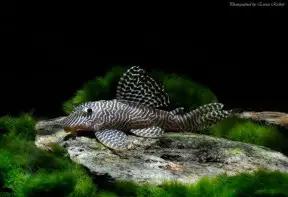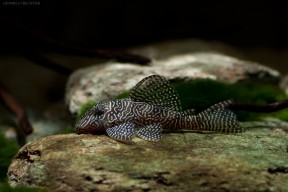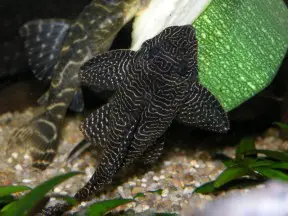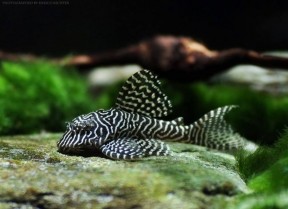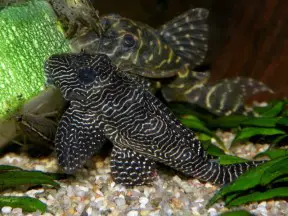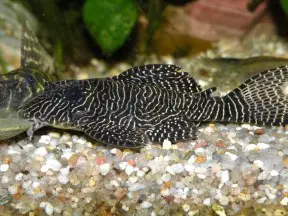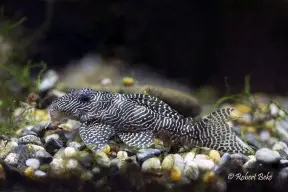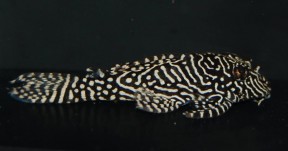Hypancistrus sp.
L260, Queen Arabesque Pleco
Etymology
Hypancistrus: from the Greek ὑπό (hypó), meaning ‘below, beneath, under’, and the generic name Ancistrus, in reference to the reduced dentition compared with the latter.
Classification
Order: Siluriformes Family: Loricariidae
Distribution
Known only from the lower rio Tapajós in Pará state, northern Brazil, from Santarém at its mouth to the village of Pimental, south of Itaituba.
The Tapajós is a major tributary of the lower Amazon and the area in which L260 is collected would be largely destroyed should a planned hydroelectric project go ahead.
Maximum Standard Length
80 – 90 mm.
Aquarium SizeTop ↑
An aquarium with base dimensions of 90 ∗ 30 cm should be the smallest considered.
Maintenance
Not difficult to maintain under the correct conditions; we strongly recommend keeping it in a tank designed to simulate a flowing stream with a substrate of variably-sized rocks, sand, fine gravel, and some water-worn boulders.
This can be further furnished with driftwood branches, terracotta pipes, plant pots, etc., arranged to form a network of nooks, crannies, shaded spots, and broken lines of sight.
Like many fishes that naturally inhabit running water it is intolerant to accumulation of organic pollutants and requires spotless water in order to thrive, therefore weekly water changes of 30-50% tank volume should be considered routine. A moderate-to-high proportion of dissolved oxygen and some water movement are also appreciated, meaning power filter(s), additional powerhead(s), or airstone(s) should be employed as necessary.
Water Conditions
Temperature: 24 – 30 °C
pH: 5.5 – 7.5
Hardness: 18 – 268 ppm
Diet
Wild specimens are probably omnivorous, with a preference for aquatic invertebrates and other small animals.
In the aquarium it does best when offered a varied diet comprising sinking dried foods, frozen Daphnia, mosquito larvae, chironomid larvae (bloodworm), and prawn/shrimp, for, example, while some raw potato and other vegetables might also be accepted.
Home-made foods using a mixture of natural ingredients bound with gelatin are very useful since they can be tailored to contain fresh vegetables, Spirulina, etc., alongside meatier ingredients.
Behaviour and CompatibilityTop ↑
A generally peaceful species which can be maintained in a well-chosen community alongside other quiet fishes.
It should not be maintained alongside other Hypancistrus spp. in order to prevent hybridisation, nor will it compete well with excessively territorial or otherwise aggressive tankmates.
Sexual Dimorphism
Adult males possess a broader head plus more extensive odontodes on the leading pectoral-fin rays and interopercular region than females, while older males may darken in colour somewhat.
Males are also more slender and less stocky than females, a difference which is easily observed when the fish are viewed dorsally.
Reproduction
Cave-spawner with the male responsible for brood care. Has been bred regularly in aquaria.
NotesTop ↑
This unidentified taxon is among the most popular loricariid catfishes in the aquarium hobby and available on a regular basis.
A similar-looking, larger form from the rio Jarí, which enters the Amazon from the opposite bank a few hundred kilometres downstream from the Tapajós has been assigned the code L411.
The two can be told apart relatively easily since in L260 the white vermiculations on the body are significantly finer than in L411, in which the black and white components of the colour pattern are of more-or-less equivalent width.
The genus Hypancistrus is diagnosed from all other loricariids by a wide separation between the metapterygoid and lateral ethmoid, presence of a sharply angled adductor palatini crest of the hyomandibula, and no lateral wall in the metapterygoid channel.
More useful for aquarists is the fact that in Hypancistrus the dentary teeth are about twice as long as the premaxillary teeth (vs. dentary and premaxillary teeth of approximately equal length).
The genus is otherwise remarkable for the fact that the majority of species have not yet been described to science, although many are well-established in the aquarium trade. As of January 2016, there are eight described species in the genus: the type species H. zebra Isbrücker and Nijssen 1991, H. inspector Armbruster 2002, H. contradens Armbruster et al. 2007, H.debiliterra Armbruster et al. 2007, H. furunculus Armbruster et al. 2007, H. lunaorum Armbruster et al. 2007, H. margaritatus Tan & Armbruster 2016 and H. phantasma Tan & Armbruster 2016.
References
- Armbruster, J. W., 2002 - Copeia 2002(1): 86-92
Hypancistrus inspector: a new species of suckermouth armored catfish (Loricariidae: Ancistrinae). - Armbruster, J. W., N. K. Lujan and D. C. Taphorn, 2007 - Copeia 2007(1): 62-79
Four new Hypancistrus (Siluriformes: Loricariidae) from Amazonas, Venezuela. - Stawikowski, R., A. Werner and I. Seidel, 2004 - DATZ: 1-132
DATZ Special: L-Numbers. - Tan, M. and J. Armbruster, 2016 - ZooKeys 552: 123-135
Two new species of spotted Hypancistrus from the Rio Negro drainage (Loricariidae, Hypostominae)

